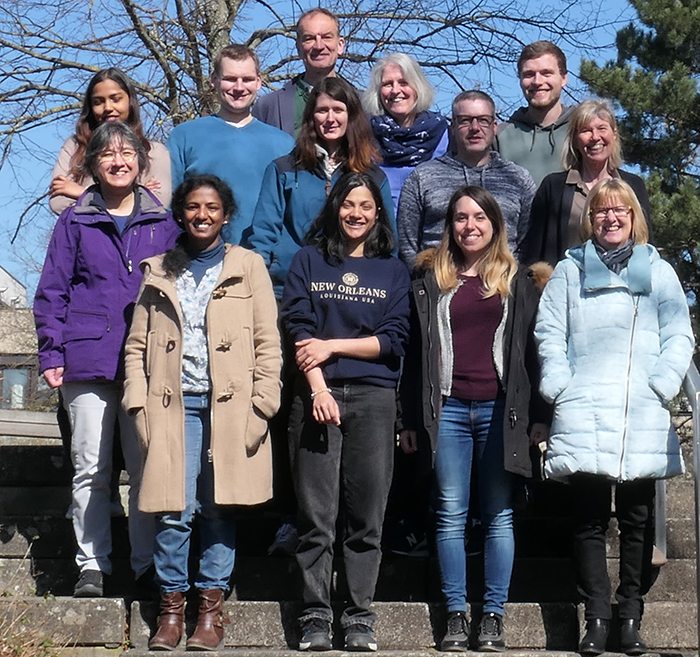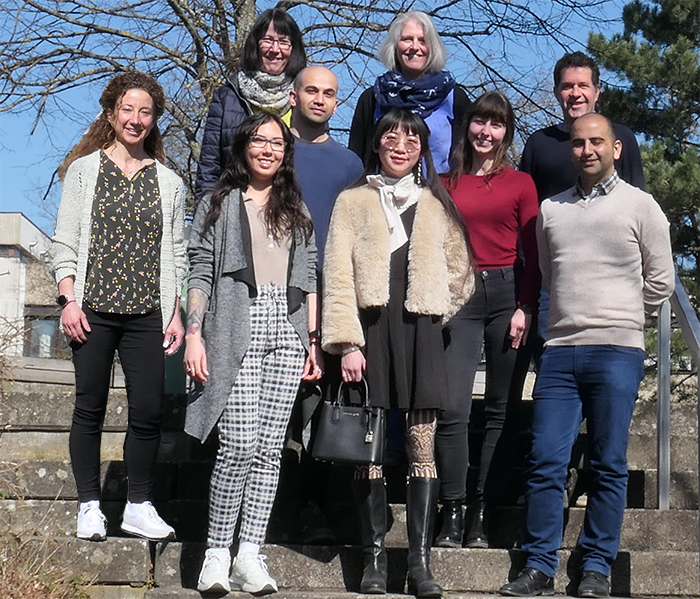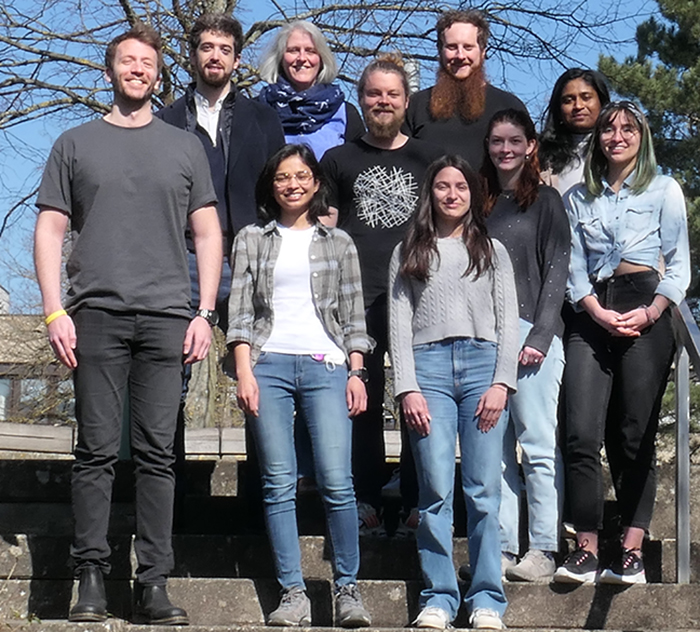Overview Research
To ensure survival in an ever-changing, complex world, animal behavior needs to be flexible and adaptive. Nervous systems have evolved to enable behavioral responses to a wide variety of sensory stimuli, but the adequate behavioral response to a given stimulus is highly context-dependent, and behavioral or internal states accordingly affect sensorimotor processing. For example, locomotion modulates responses of visual neurons, and hunger increases food-searching behavior and shifts taste preferences. Despite their ubiquitous importance, the neural mechanisms enabling context-dependent sensorimotor flexibility are not well understood. My Emmy Noether research program ‘Neural mechanisms enabling context-dependent sensorimotor flexibility’ aims to discover fundamental principles of motor control, in particular with regard to sensorimotor flexibility, by leveraging the power of neurogenetics, electron microscopy-based circuit reconstruction, and in-vivo patch-clamp recordings in behaving Drosophila.
Homepage Emmy-Noether-Programme
The Ache Lab is part of a NeuroNex Network with the goal of addressing the foundational question: How do biological nervous systems control and execute interactions with the environment?
Our network, which includes scientists and engineers from ten institutions across the United States, the United Kingdom and Germany, is focusing on Communication, Coordination, and Control in Neuromechanical Systems (C3NS) to develop comprehensive models of sensorimotor control with relationships to the environment, both within individual species, and across the phyla Arthropoda, Mollusca and Chordata.
Together, we seek to create a conceptual modeling framework that can predict control for organisms of different size and speed scales. Through our inter-phylum experimental study of sensorimotor control, we seek to identify convergent or conserved principles to refine and inform this framework. Such a framework will have a tremendous effect on the ability to interpret, and extend the impact of, experimental results across biology and robotics, with future applications to prosthetics.
The Ache Lab will closely collaborate with the Büschges, Ito and Blanke Labs at the University of Cologne and Nick Szczecinski’s Lab at the University of West Virginia to contribute a model of Drosophila motor control to the project. C3NS is led by Roger Quinn at Case Western Reserve University.
C3NS Homepage: https://case.edu/neuronex/
Chronobiology is the study of biological rhythms. The best understood cycles are those with circadian 24 hour periods that modulate the temporal dynamics of physiology and behaviour of all higher organisms and some bacteria. Four model organisms have been widely used to study the underlying biology of circadian clocks, Cyanobacteria, the fungus Neurospora, the fruitfly Drosophila, and the mouse. CINCHRON is an integrated European centre of excellence for the research training of researchers in the emerging multidisciplinary field of Comparative INsect CHRONobiology.The 2017 Nobel Prize for Medicine or Physiology was awarded jointly to three of our colleagues, Jeffrey Hall and Michael Rosbash (both at Brandeis University, Boston, USA) and Michael Young (Rockefeller University, New York, USA) for their work on the molecular dissection of the circadian clock in Drosophila. Our warmest congratulations to these outstanding fly molecular geneticists for their achievements, which is particularly heartfelt because seven of the principle investigators of CINCHRON have worked and published with Hall and Rosbash.Insect clocks, both circadian and seasonal, are vital for adaptation to the environment and recent global patterns of climate change mean that insect pests and vectors of disease are expanding their ranges into Europe. Consequently there is an urgent need to study the circadian clocks of these insects and how they synchronise to the environment.CINCHRON will contribute to the integration and cohesion of future European research efforts in solving pure and applied biological problems.
Our investigations will provide the first basis in understanding the role of the circadian clock in seasonal adaptation using the well characterized model Drosophila melanogaster. In addition, we will contribute to the understanding of circadian clock evolution by investigating fruit fly species adapted for a life at different latitudes.
For more information on the project FO 207/15-2 , please click on the project
FO 207/15-2
Animals have to adapt to seasonal changes in the environment. A too late adaptation to the coming winter will definitively cause their death. Insect start to hibernate (=diapause) when temperatures drop and day-length (photoperiod) decreases below a certain critical value. It is generally thought that the circadian clock is crucial to measure day-length, but the mechanisms how this is done and how the signals about day-lengths are transformed to the diapause inducing hormonal centres in the insect brain are largely unknown.
This Marie Curie Network aims to uncover the mechanisms of photoperiodic control in four model species: The parasitoid wasp, Nasonia vitripennis, the Lindenbug, Pyrrhochoris apterus, the Olive fly, Bactrocera oleae and the genetic model system Drosophila melanogaster. ..more
Funded at the Julius-Maximilians-University of Würzburg from 2013 to 2017
Timing plays an important role in all living systems. Endogenous clocks enable organisms to anticipate and adapt to daily or seasonal variation in environmental conditions. Being at the right time at the right place crucially determines the chance to find sufficient food, the success of mating, the success in raising brood, the chance to synchronise with mutualistic interaction partners and the likelihood to escape antagonists or harmful environmental events. Thus, proper timing of development, maturation, population phenology and a wide range of different behaviours is of paramount importance for the reproductive success and survival of all animals. Under laboratory conditions, the molecular basis of daily timing via endogenous clocks is intensively studied in few model organisms such as Drosophila melanogaster. However, little is known about the functional impact of such clocks in real nature. Our knowledge on timing mechanisms on time scales exceeding one day is even scarcer and restricted to few species. We also do not know how endogenous clocks and other timing mechanisms promote the adaptation to changing environmental conditions. Further, the impact of clocks and other evolutionary achieved timing mechanisms on the fitness of individuals, eusocial insect colonies, or on the synchronisation of multitrophic biotic interactions are little understood.
The Collaborative Research Centre (CRC) addresses these important questions using anintegrative approach. We focus on insects, since insects are in particular masters in behavioural timing and in adapting quickly to changing environmental conditions, which made them the predominant animal taxon on our planet with enormous ecological impact. We investigate mechanisms of proper timing in selected species at the molecular, cellular and neuronal networklevels, analyze the influence of timing on individual behaviour and interactions in social groups,populations, and communities, and, ultimately, determine the impact of proper timing on fitness. Each of these levels is important for its own sake. Yet, the new and important step we take here is to integrate the analyses of the different proximate/mechanistic levels of timing into an ecological context (success on a daily base, throughout the individual life span, and across generations).
The proposed CRC intends to establish a platform integrating different biological subdisciplines
ranging from molecular biology via neuroethology to ecology in order to promote vivid synergistic interactions among them. The research of this CRC goes beyond current studies in the individual biological disciplines and brings together ecological concepts with mechanistic research on the molecular, neuronal and organismic level. Our long term goal is to elucidate the proximate mechanisms underlying timing, and at the same time, unravel the ultimate consequences of proper timing for fitness in real ecosystems and in the context of global environmental change.
Our investigations will provide the first basis in understanding the role of the circadian clock in seasonal adaptation using the well characterized model Drosophila melanogaster. In addition, we will contribute to the understanding of circadian clock evolution by investigating fruit fly species adapted for a life at different latitudes.
For more information on the projects FO 207/15-1 and ME 4866/1-1 that are both part of this research work, please click on the projects respectively
FO 207/15-1
ME 4866/1-1











